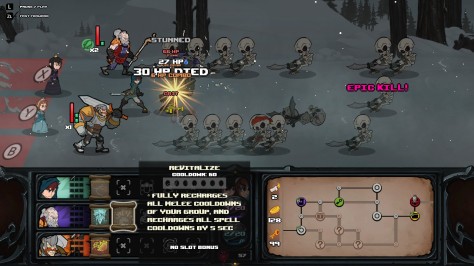
With the rise in popularity of roguelikes in the last decade I’m almost embarrassed to admit the time I’ve spent with Has-Been Heroes constitutes my most consequential experience with the genre. Developed by Finnish studio Frozenbyte and published by GameTrust, it caught my eye when I saw it on the shelf; a physical Switch game for $20… why not? Going in blind I was earnestly hoping for a JRPG like experience but I was intrigued by the purported blend of action and strategy elements. However, my enjoyment quickly tapered off as I came to grips with the intense difficulty. After persisting for a couple hours, everything clicked and I began to survive longer and unlock more. It’s a difficult game with high odds for bad runs but when everything falls into place, it’s immensely satisfying.
The game made a great first impression with a humorous animated introduction. It established the “has-been heroes” as just that: heroes past their prime but dutifully ready to complete their final quest: delivering the princesses safely to school. Their school was a long way off, on the other side of many treacherous areas, of course. Joining them was a spry young rogue looking to learn from the (once) best. Beyond that, further exposition was limited. As the party encountered merchants and camps brief dialogue prefaced my actions. Successfully completing runs resulted in a closing animation as well. Although the game only had the basic framework of story and progression I wasn’t bothered.

After each successful run, the heroes’ journey expanded, with the next run including an additional area to traverse. A new character was unlocked as well, allowing me to diversify the party beyond the original three heroes. An ever-present minimap displayed the current area in full on the bottom right. I plotted their path with the right analog stick aiming for as many unknown nodes as possible before fighting the area’s boss. Nodes remained unmarked until the party was in traveling distance. They could be a skirmish or a vendor, among other alternatives. Backtracking was possible but required an uncommon item, so I had to make each move count. Spells and items were the means of powering up the heroes so it was imperative that I cover as much ground to obtain gold from enemies and increase the odds of finding beneficial items and spells. Those improvements were put to the test in battles.
Battles oriented around three lanes, a hero on one side of each with enemies advancing from the other side. Heroes and enemies alike had a stamina and health bar. Before decreasing the health bar of an enemy, I needed to deplete their stamina bar. Additionally, after an enemy’s stamina bar was depleted, they’d remain stunned for a period of time. Every run began with three heroes, one from each class. Think of the players from Ice Hockey for the NES and you’ll get the idea: small/weak, average, and big/strong. It took a few runs before I really grasped the fact that if an enemy had three points of stamina, I needed to line up the hero who swung three times and then switch in the heavy hitter who only swung once but packed a wallop to their health. Once I did, everything started to click.

Properly managing each lane was the key to success, regardless of how powered up each hero was. Even in unlucky runs, I could overcome stacked odds with strategy. Heroes could switch lanes with someone who just advanced on an enemy and after a few runs, I was beginning to do so with lightning speed and forethought, taking into consideration proximity of enemies, the stamina of those further down the pike, and each hero’s melee refresh rate. It was satisfying to quickly and meticulously plan out each action and see it come together. Coupled with the good fortune of receiving many spells and smart usage, I could keep the odds on my side.
Each hero was affiliated with a different element, and had spell buffs relating to their specialty. In planning out who took what spell, I factored in their affiliation, spell slot position, and if they had received items that reduced their spell recharge time or increased spell power. For example, my best run thus far occurred with the rogue (neutral), bard (water), and wrestler (lightning). I managed for the rogue to receive a 5 second invulnerability spell in a spell slot that applied it to every hero. The bard had four total offensive spells and I’d managed to increase his spell power and decrease his spell recharge rate many times. Lastly, the wrestler had a lightning spell in a spell slot which increased the arcing effect. Furthermore, dousing enemies with the bard and then striking them with the wrestler’s electric spells resulted in double damage. I got such a high when runs came together like this. Unfortunately, they all didn’t go so swimmingly.

Dead runs, those runs where I didn’t beat the final boss, were the norm. These were incredibly demoralizing early on but vital learning experiences. After a couple hours, once I understood the gameplay loop and the dynamics of the heroes I was using, the game clicked. I began micromanaging at light speed and took pride in executing impressive combos or overcoming stacked odds. It was still a very difficult game due to the randomness but I no longer found it demoralizing. If anything, I grew a little vindictive, having to fight off the urge to jump right back in for fear of fatigue. This game was great in short bursts or single runs; otherwise it wore out its welcome. Regardless, I’ve spent way more time with Has-Been Heroes than I anticipated after a frustrating start and have found it immensely satisfying.
